by Carolyn Edlund
A recent conversation with Hawaii-based entrepreneur Thomas Deir reveals his recipe for success while staying true to his vision as an artist.
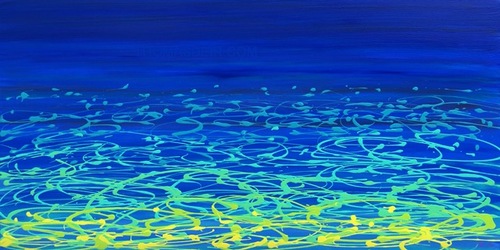
Ocean Reflection, 24″ x 48″ by Thomas Deir
Thomas Deir is an artist, inventor, and business owner. He specializes in tile murals, paintings, and mosaics for homes and businesses. He has invented a heat setting synthetic oil paint (Genesis Artist Colors), been commissioned for a $100,000 painting for the USA Inventor’s Hall of Fame, and completed numerous private and commercial projects for clients in Hawaii, Florida, Texas, California, Ohio, Guam, Japan, Canada and many other parts of the world.
His mission? Lead a positive life. Believe in the good in people; be kind, compassionate, humble and patient. Think of consequences when making decisions and recognize mistakes as an opportunity to learn. Strive for perfection and then be satisfied because you have done your best, and nothing is perfect. Know that gratitude is the key to happiness and that discipline is the key to success.
We recently spoke about what he’s learned throughout his career, and by expanding his business to new markets.
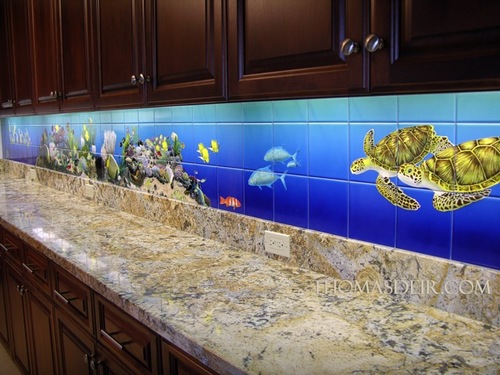
Kitchen backsplash, “Aquarium Reef” by Thomas Deir.
AS: You feel that successful artists embrace a win/win relationship with their clients. Could you explain?
TD: Success is really all about relationships. Whether your “client” is a residential commission, a commercial business, or an art gallery, there are people involved in creating a win/win relationship. Doing your best by listening and contributing in a sincere and selfless manner.
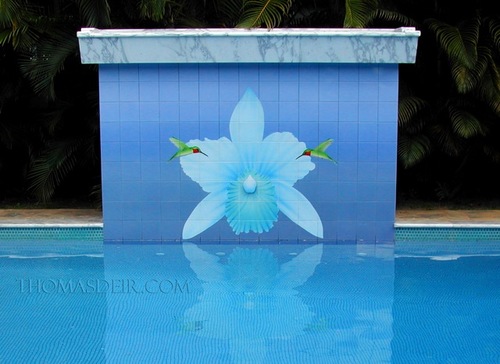
Orchid Pool Waterfall Wall Tile Mural by Thomas Deir
AS: Talk about the breadth and diversity of the markets you approach, and the products you sell. How did your business evolve from painting into bath/kitchen design/commercial interiors, and more?
TD: I became an artist because I love to problem solve with creativity. Part of the excitement of creating is having new projects, new clients, and new challenges that result in a more diverse portfolio and skill set. Diversity of subject matter and mediums also widens your client base – in other words, you appeal to more people.
In the beginning, we are all new and hungry, and understandably a bit unsure. It is only through practice (in art and people skills) that we grow confident and increase our abilities. As a young artist you may accept a commission for a certain budget and afterward determine that you didn’t profit. But what did you learn about techniques, processes, and relationships that will help you in the future? What was that worth?
When I was a child, I was eager and ambitious. I dove into anything that was related because I knew it would become a tool in the future. I explored the options that were available including drawing, photography, architecture, acting, and music. I became fascinated with visual arts and recognized that the principles of design and composition are foundational to all visual art.
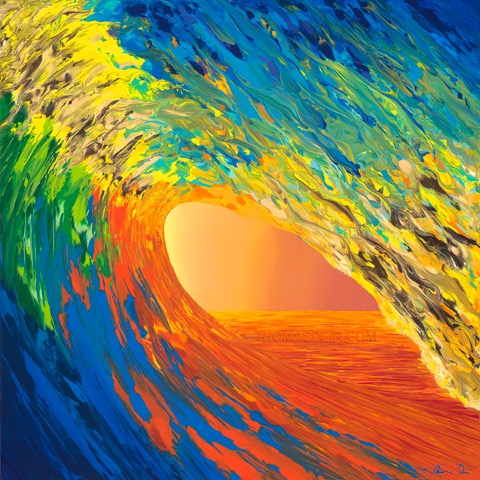
“Liquid Jewel Wave” 24″ x 24″ by Thomas Deir
When I discovered graphic design, I started from the ground up. By the time I was 15, I was an assistant in a signage department of a major advertising agency in Honolulu. I acquired as much knowledge as possible about sign fabrication and installation. It was a valuable experience. I learned to apply mechanical principals and developed a unique problem-solving ability that has served me well over time.
I then became the youngest art director at a major Honolulu advertising agency (Sellers Advertising) at 21 and I thought I would become a graphic artist, getting a paycheck every two weeks. But I became hungry for more, and started experimenting with tile because I saw the permanency in that medium.
Then I met John Pitre, my mentor, with whom I invented Genesis Artist Colors. I became a top selling marine artist in Hawaii, and then was labeled as a marine artist. Eager to learn more, I started painting seascapes and landscapes, all using classical glazing techniques for realism. That was 23 years ago.
Today I still paint and do the tile murals and the turtle mosaics, but in the last two years I’ve explored abstract art with acrylic paint, pouring the paint on the canvas and using my fingers as brushes. I’ve recently come back from San Francisco where I’ve established some positive relationships for future art shows and gallery representation.
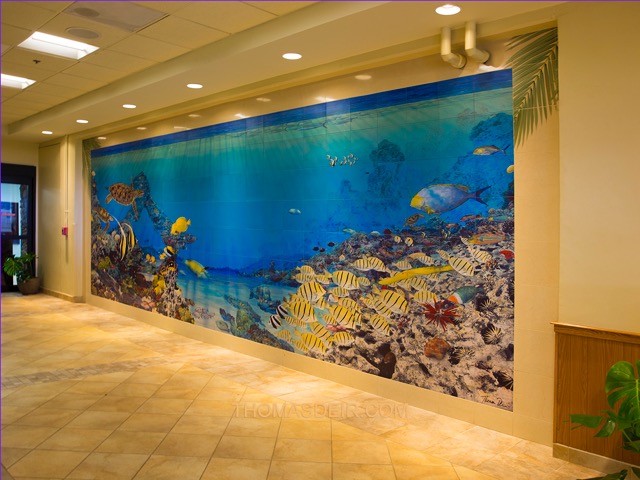
Mural at Hale Koa Hotel in Waikiki by Thomas Deir
AS: How do you feel licensing will help promote your art and create demand?
TD: Licensing does two things: 1. It exposes your work. 2. It creates income without effort. I suggest artists try to hold on to their originals as long as they can, while they reproduce and market their work. It’s the basic business principle of supply and demand. There is only one original, and as the demand grows through exposure, that original increases in value.
AS: What is your advice for other artists who want to build vibrant, growing businesses?
TD: Sales and marketing – we’ve all heard this before, but it really should be marketing and sales because sales are a result of marketing. If you don’t expose your work or if you are afraid someone will steal your idea or your art, then being a professional artist is not for you. You will inhibit your own growth.
If you are going to make a business of art, then consider yourself a commercial artist. You can call yourself a commercial fine artist if that makes you feel better, but really what it comes down to is thinking about saleability. Study and observe what people are buying, what colors are in, so you can apply these to your art so that it will sell!
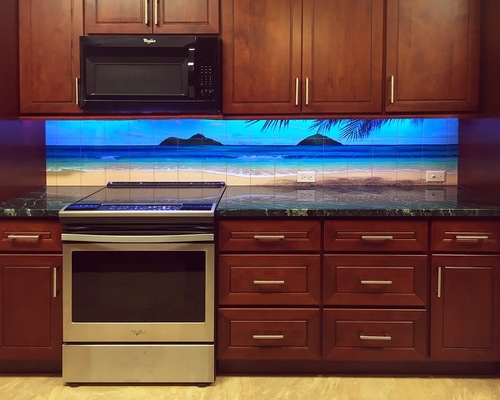
“Paradise Rainbow” Kitchen Backsplash by Thomas Deir
Many artists make a mess and are disorganized. Part of the creative process is focusing on the work and making a mess, but if you don’t clean up afterwards and get organized, when you reach for that certain tool (brush, color, X-Acto knife, etc.) you will turn the positive creative flow into a negative frustrating interruption as you look around your mess for that tool while paint dries. I often compare myself to a surgeon (without the liability) or a chef. A surgeon or a chef needs to have all their tools organized to be successful. Another aspect is timing. Effective preparation will insure that when the “procedure” begins, you will be able to do your best. Think it out before and get organized!
Artists who want to build a vibrant, growing business need the right attitude. Attitude is the driving force and the navigator in life. Positive attitudes open doors, make mutually beneficial relationships, and attract positivity.
Try new things. Even if you are not confident, don’t be afraid to try. Do not let fear inhibit your growth. No one became good at anything without that first effort. Believe in your potential. Make mutually beneficial relationships. Develop a passion for learning, rather than a hunger for approval. Every successful person took risks, and they did not do it alone!


This is an excellent article on the business perspective from someone who has obviously gone deep on the path of commercial art. I like the bit about licensing; I haven’t heard it put that way before about taking a long term view on the value of your artworks. I’m always curious about people who do murals and commissions – does the artist sometimes get to own the right to license that artwork for other purposes or does the client own it entirely? Can the artist license that artwork for reproduction in other formats? Surely anything can be negotiated before a commission contract is signed but is there a standard expectation?
Aloha Kevin, my understanding is that unless there is a contract specifying that the mural can be used for reproduction, those rights are with the artist. That would be the standard expectation. Perhaps a copyright attorney can verify this.
He has a good attitude that he tries to pass on to others. Tells you things to encourage you. Sometimes just need that when you feel like you are in it all by yourself.